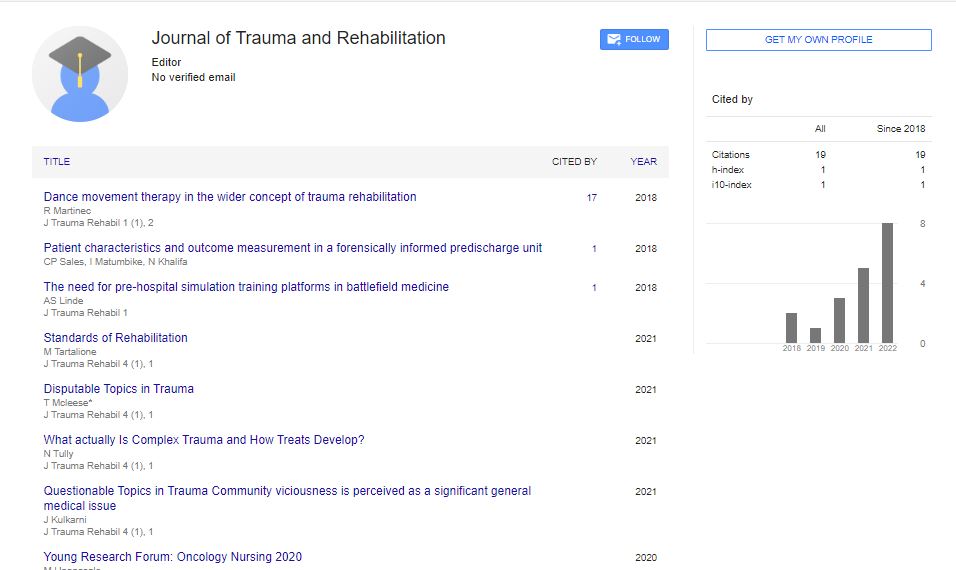Commentary, J Trauma Rehabil Vol: 6 Issue: 4
Novel Approaches in the Field of Orthopedic Trauma
Attum Whiting*
1Department of Orthopedics, University of Oxford, Oxford, United Kingdom
*Corresponding Author: Attum Whiting,
Department of Orthopedics, University of
Oxford, Oxford, United Kingdom
E-mail: attwhiti@orthor.ox.ac.uk
Received date: 24 November, 2023, Manuscript No. JTR-24-127954;
Editor assigned date: 27 November, 2023, PreQC No. JTR-24-127954 (PQ);
Reviewed date: 11 December, 2023, QC No. JTR-24-127954;
Revised date: 18 December, 2023, Manuscript No. JTR-24-127954 (R);
Published date: 26 December, 2023, DOI: 10.4172/Jtr.1000139
Citation: Whiting A (2023) Novel Approaches in the Field of Orthopedic Trauma. J Trauma Rehabil 6:4.
Description
Orthopedic trauma, characterized by injuries to the musculoskeletal system often resulting from accidents, falls, or other traumatic events, has long been a focal point of medical intervention. The landscape of orthopedic trauma care is continually evolving, driven by advancements in technology, surgical techniques and a deeper understanding of biomechanics. Advanced imaging techniques, the novel imaging modalities are revolutionizing the diagnosis and assessment of orthopedic trauma. High-resolution Computed Tomography (CT) scans, Magnetic Resonance Imaging (MRI) and Three-Dimensional (3D) reconstructions provide unprecedented inputs into the complexities of musculoskeletal injuries. These technologies aid surgeons in preoperative planning, allowing for more precise surgical interventions and improved outcomes. The integration of biologics and regenerative medicine is transforming the landscape of orthopedic trauma treatment. Platelet-Rich Plasma (PRP), mesenchymal stem cells and growth factors are being employed to enhance tissue healing and promote regrowth of damaged bone and cartilage.
These biologically driven approaches have potential for accelerating recovery and minimizing long-term complications. Customization is a key theme in contemporary orthopedic trauma care. Patient-specific implants, designed based on individual anatomy through advanced imaging and Computer-Aided Design (CAD), optimize the fit and function of orthopedic hardware. This customized approach improves implant stability, reduces complications and enhances overall patient outcomes. Minimally Invasive Surgery (MIS) techniques are gaining prominence in orthopedic trauma care. These procedures involve smaller incisions, leading to reduced tissue damage; faster recovery times and decreased postoperative pain. From fracture fixation to joint reconstruction, MIS approaches are changing the surgical landscape and providing patients less invasive but equally effective treatment options.
Robotics is playing an increasingly significant role in orthopedic trauma surgery. Robotic-assisted systems provide surgeons with enhanced precision and control during procedures, particularly in challenging anatomical locations. This technology is employed for fracture reduction, joint arthroplasty and spine surgery, augmenting surgical capabilities and improving patient outcomes. The integration of telemedicine and remote monitoring technologies is facilitating more comprehensive and accessible postoperative care for orthopedic trauma patients. Remote consultations, virtual follow-ups and smart devices for monitoring rehabilitation progress allow for ongoing assessment and timely interventions, particularly important in situations where regular in-person interactions may be challenging. Customizing rehabilitation protocols to individual patient needs is gaining prominence in orthopedic trauma recovery. Understanding the unique aspects of a patient's injury, lifestyle and goals allows for the development of personalized rehabilitation plans. This approach maximizes functional recovery and improves long-term outcomes. The use of data analytics and predictive modeling is transforming decisionmaking in orthopedic trauma care. Analyzing large datasets helps identify trends, predict potential complications and optimize treatment strategies. Machine learning algorithms are being developed to assist in predicting patient outcomes based on a variety of factors, contributing to more inform clinical decision-making.
A shift towards collaborative, multidisciplinary care is evident in the management of orthopedic trauma. Teams comprising orthopedic surgeons, physical therapists, pain specialists and mental health professionals work together to address the multifaceted aspects of trauma recovery. This comprehensive strategy recognizes the interconnected nature of physical and psychological well-being in orthopedic trauma patients. The novel approaches in the field of orthopedic trauma are beginning a new era of personalized, technologically advanced and multidisciplinary care. From precision surgery facilitated by robotics to regenerative therapies, utilizing the human body's natural healing processes, these innovations are reshaping the landscape of orthopedic trauma care.
 Spanish
Spanish  Chinese
Chinese  Russian
Russian  German
German  French
French  Japanese
Japanese  Portuguese
Portuguese  Hindi
Hindi 